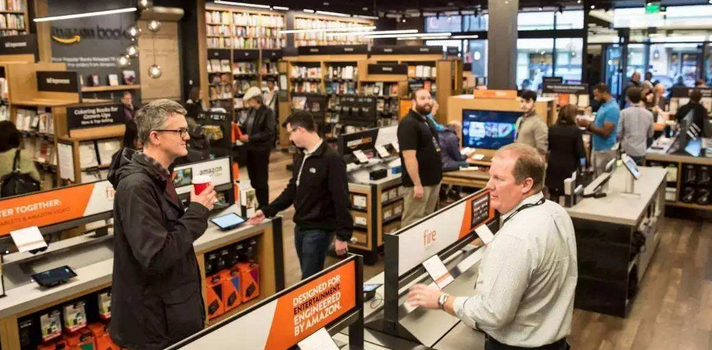Recently, Mary Meeker, an analyst at Wall Street Securities, known as the "Queen of Internet", mentioned in the 2017 Internet Queen Report that the number of offline retail stores closed down a record in 20 years, but e-commerce giants such as Amazon have "took against the trend" to open offline physical stores, and the number is increasing.
The same is true in China. Although China's e-commerce currently has the fastest penetration rate among major markets around the world, accounting for 15% of the total retail sales of social goods in the country, e-commerce giants including Alibaba, JD.com, Xiaomi are all laying out offline retail stores in the craze of e-commerce in the retail industry.

The e-commerce giants who are playing online are turning their attention offline, which many people can’t understand. Are offline not expensive rents, poor services, and low profits? What exactly do they like?
Recently, an article by Wall Street News mentioned that after a period of trial operation, Amazon officially opened two physical grocery stores in Seattle, USA, and Amazon also opened a new physical bookstore in New York. Currently, Amazon has 7 physical bookstores, and plans to open another 6 in the future.
Although it is not very successful in China, Amazon is the well-deserved founder of e-commerce around the world. Amazon's sales reached $136 billion last year, and according to research firm Slice Intelligence, the sales accounted for 43% of the online sales in the United States in 2016. Thanks to the continued improvement in performance, in April this year, Amazon's stock price once rose above the $900 mark, setting a new record high, which made Amazon CEO Jeff Bezos the second richest person in the world.
As retail industries are turning online, Amazon has begun to deepen its efforts offline. What is the reason?
An important data is that offline retail seems to be pressing online step by step, but in terms of proportion, it is a different situation. eMarketer data shows that global retail sales last year were US$22 trillion, while e-commerce retail only accounted for US$1.9 trillion, less than 10%. Only 15% of countries like China with highly developed e-commerce account for. It can be seen that offline retail still contains huge business opportunities.
As online competition is becoming increasingly fierce and the Internet population dividend is gradually diluting, JD.com has also turned its attention offline and has repeatedly put forward big moves.
On April 10, JD.com CEO Liu Qiangdong announced that the "Million JD Convenience Store Plan" was officially released. In the next five years, JD.com will open more than 1 million convenience stores nationwide. Half of them are in rural areas and every village has them. This is the third offline cooperation project that JD plans to launch after 10,000 JD home appliance stores and 5,000 "maternal and child experience stores".
JD.com's offline layout is also easy to understand from the current development status of China's Internet. Meituan CEO Wang Xing said: "China's Internet users have accounted for more than half of the total population, and it is no longer realistic to rely on the increase in the number of netizens to drive the market." The competition in the second half of the Internet has shifted from demographic dividend to user value-driven. In the future, providing users with more personalized and self-service services will be more popular. This is also JD.com's logic. Community convenience stores are small in size and are also a service terminal closer to user's lives. Using community convenience stores to manage user relationships and sticking to users with services will become the key to improving corporate competitiveness and Internet transformation, which will be the general trend.
And it should be seen that community convenience stores, specialty stores and experience stores also have the effect of online and offline linkage. For example, consumers can enjoy the preferential prices of online marketing activities and directly shop and pick up goods. If they meet the 1-kilometer radiation range of the convenience store, they can also place orders on the platform. The convenience store provides delivery services for purchases.
In the future, the competition for retail, whether online or offline, may be a competition for services.

Which one is the mainstream in the future, online or offline?
While e-commerce giants are returning to offline, Walmart, a world-renowned offline retailer, is actively entering the online business. In 2017, it acquired Shoebuy in January; in February, it increased its shareholding ratio of JD.com to 12%, and acquired Moosejaw; in March, it acquired Modcloth.com...
The reason for Walmart to enter e-commerce seems to be very simple. There is a Walmart supermarket within 10 miles (about 16 kilometers) where 90% of Americans live. There is no shortage of offline, and online is a good supplement.
In a sense, this is a requirement for the integration of new retail online and offline, and it is necessary to combine the spirit of Internet service first and offline experience with convenience. "I don't think retail is dead, but the mediocre retail experience is dead," said Warby Parker Co-CEO Neil Blumenthal.
Every e-commerce giant is actually a big data company. They not only master massive consumer data, but also have profound data, technical understanding, and the technology and application capabilities developed based on all this. E-commerce giants use the precise data of hundreds of millions of online consumers in China, including consumption habits, consumption levels and residences, in order to form user portraits and accurately match products with users. Commenting on Amazon's offline strategy, Mark Hamrick, senior economic analyst at BankRate.com, said, "Data is becoming a new crude oil, a valuable resource. Amazon integrates the data it collects into the offline world with the goal of expanding its leading position in the global retail business."
This is also the business logic of online and offline integration. E-commerce giants will use the collected data to empower offline channels. Through the precise matching of big data, the retail store closest to him can deliver goods to him immediately after the user places an order; even if the user has not placed an order, big data will know what you will buy, so as to prepare stock in advance and completely solve the troubles caused by inventory backlog and logistics transportation.
From the expansion from online to offline, integrating traditional channels with new technologies, retail in the future will be more efficient, and the era of supplying according to needs may soon come!
Thank you for your attention and support to Laogao Crown Club . Please indicate the source of the reprinting website www.shxuanming.net
Click to register to apply to join the well-known e-commerce network - Laogao Crown Club. Any merchants from all over the country, Tmall merchants, Taobao Crown Stores, Jinguan Stores, and other e-commerce platform merchants can apply to join!




![#Laogao E-commerce Newsletter#[E-commerce Evening News on May 19]](/update/1652145126l900304477.jpg)
![#Laogao E-commerce Newsletter# [March 31 E-commerce Evening News Brief]](/update/1680254488l508456710.jpg)


 EN
EN CN
CN
